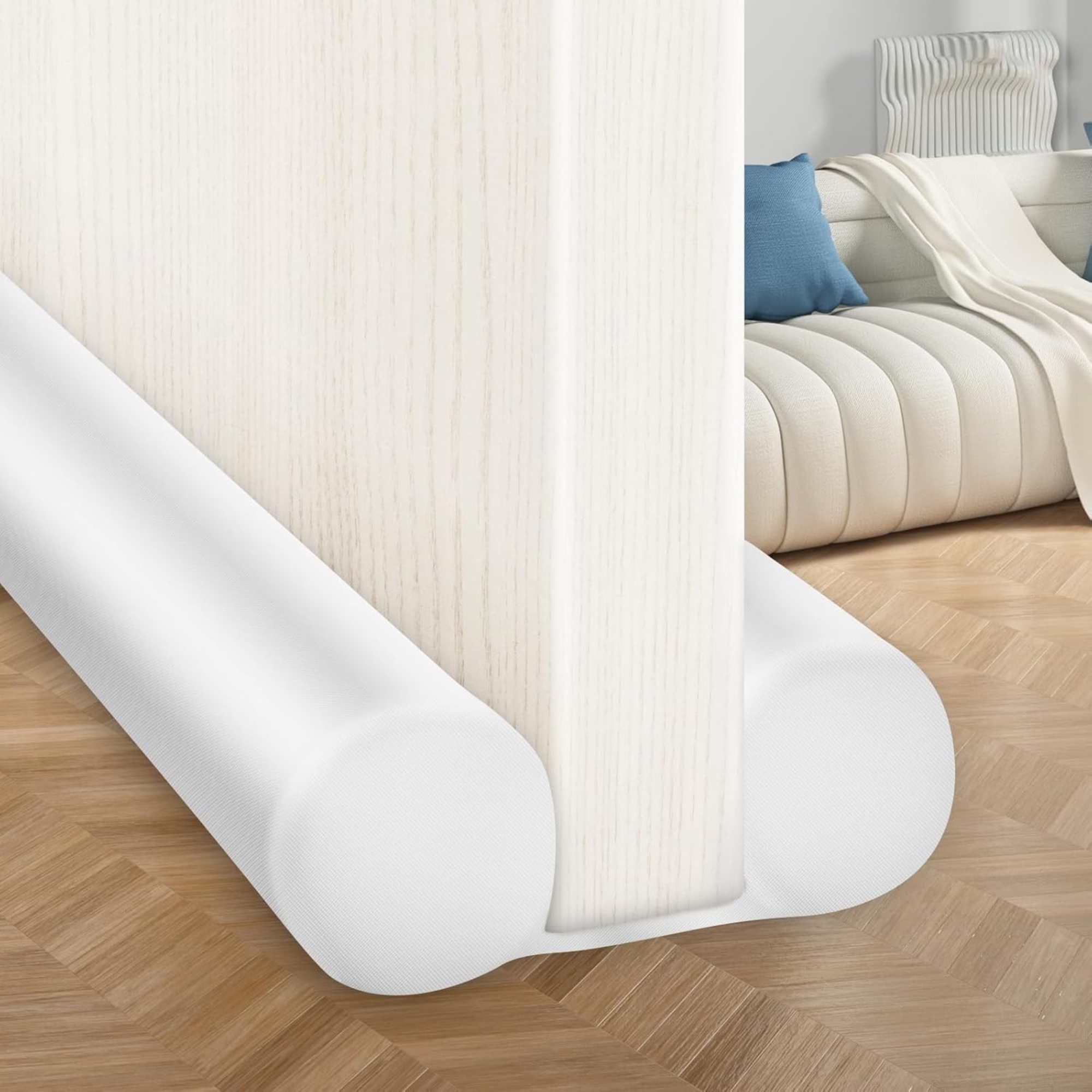How to draft proof your bedroom for cozy and comfortable sleep
Create a warm space for your winter slumber with our expert advice


A drafty bedroom can disrupt sleep and drive up energy bills, especially during colder months. Draft-proofing helps create a cozy, quiet, and energy-efficient space for your winter slumber.
In this article, heating, ventilation and air conditioning (HVAC) experts reveal exactly how to do it, including the best products to use and the common mistakes to avoid.
Knowing how to run and clean your HVAC system, as well as how to draft proof your bedroom, is key to ensuring a warm and comfortable sleep year-round.
Step 1: Inspect windows and doors

Start by identifying the primary sources of drafts. Common culprits are gaps around window frames and under doors. Head of Solved, Punteha van Terheyden found weatherstripping was a quick and easy fix for her drafty front door and this is easily used for bedroom windows and internal doors, too.
Josh Mitchell, HVAC technician and founder of Air Conditioner Lab, says, 'Keeping your bedroom draft-free is essential for a good night's sleep and overall health. Drafts can mess with the temperature, increase your energy bills, and make you more likely to get sick.
'On a windy day, check for drafts by holding a lit candle near window and door frames; any flicker will indicate air leaks. This method is simple and can pinpoint even small leaks that might be overlooked.'
Steve Pacholski, brand president of HVAC experts Varsity Zone, adds, 'Another often-overlooked source of drafts is the gap between baseboards and the floor, so it's worth using your candle to test there also. A flexible caulk can seal those gaps without much effort.'
This multi-use GE Silicone All Purpose Caulk from Lowe's is great for sealing around bedroom windows and doors.

This 100% waterproof caulk sealant is not only mold and mildew resistant, but won't yellow, shrink or crack over time. It also comes with thousands of great customer reviews.
Step 2: Apply weatherstripping

Weatherstripping is one of the simplest and most effective ways to seal gaps around windows and doors.
Mitchell says, 'Install self-adhesive foam or rubber weatherstripping along the frame where the window or door seals with the structure. Ensure the surface is clean and dry before applying to ensure good adhesion. For windows that slide or doors that you use frequently, consider using durable silicone weatherstripping, which performs well against friction and weather elements.'
Mitchell recommends this Frost King M13WH V-Shape Weatherstrip from Walmart, adding, 'This weatherstrip is versatile and easy to install. It's particularly effective for sealing both movable and stationary parts of windows and doors, offering flexibility and durability throughout the seasons.'
Applying insulation film to windows can add another layer of protection. For more tips, check out our guide on how to weatherproof your windows.

This heavy-duty insulating film blocks bedroom drafts and heat loss effectively, helping reduce energy bills by up to 20%. It’s also easy to install and remove without damaging your windows.
Step 3: Use draft stoppers

Draft stoppers are a quick fix for gaps under doors. These can be as simple as a rolled-up towel or a more permanent solution like a weighted fabric stopper.
Mitchell says, 'Door snakes are excellent for blocking drafts under doors. Choose a fabric draft stopper that matches your decor and is heavy enough to stay in place without needing constant adjustment.'
For further tips, check out our guide on how to soundproof a door.

Made with polyester wadding, this heavy, machine-washable draft stopper is a fave of our pros. Pacholski says, 'It fits most doors and does a great job of keeping out cold air.'

This stylish fabric draft snake is just the thing for keeping the wind from whistling in under bedroom doors. It's easy to set up, as there's no need to physically attach it to the frames.

Mitchell says, 'This product is filled with polyester wadding for excellent insulation properties. It's adjustable, plus it can be easily removed and washed – functional and convenient.'
Step 4: Consider heavier curtains

Thermal or blackout curtains add an extra layer of insulation to your windows. They help keep warm air inside during winter and block drafts effectively.
Mitchell says, 'Investing in heavy thermal curtains can drastically reduce window drafts. These curtains also help with thermal insulation, keeping your room warmer in the winter and cooler in the summer.'
Pacholski agrees, recommending the ECLIPSE DraftStopper Room Darkening Curtains from Amazon. He says, 'These curtains are ideal for stopping drafts because of their thick, insulated fabric that can block cold air from windows.'
Our curtain hacks for a warmer home this winter will help bring maximum coziness, including making sure your curtains fully cover the windows and extend beyond the frame.
Step 5: Seal outlets and switch plates

Electrical outlets and light switch plates on exterior walls often allow drafts to enter.
Pacholski says, 'Electrical outlets on exterior walls can easily get overlooked, but they often let unwanted cold air into the room. Installing foam gaskets behind the outlet covers is a simple fix that can stop those sneaky leaks.'
This pack of New Resources Group Electrical Outlet Gasket Covers from Walmart helps to stop drafts in their tracks.
What to avoid

Our experts advise being wary of oversealing, blocking home ventilation, and selecting sealants that might be incompatible with the materials of your bedroom windows or doors.
Pacholski says, 'While draft proofing, it’s important to avoid over-sealing the room. Completely sealing off airflow can create ventilation problems, leading to stale air or moisture buildup, which could cause mold. Instead, focus on sealing obvious gaps while still allowing the room to breathe.'
Mitchell adds, 'Check that the sealants and weatherstripping materials are suitable for the surfaces you're applying them to. For example, some adhesives can damage painted surfaces or varnished wood.
'Also, be careful not to block intentional vents or air supply registers, as these are necessary for your heating and cooling system to function properly.'
Check out our guide to whether you should close vents in unused rooms.
FAQs
Can draft proofing your bedroom help with noise reduction?
Yes, sealing drafts in bedrooms can also reduce noise from outside by blocking gaps that let sound in. Mitchell says, 'Sealing gaps and adding heavy curtains can reduce outside noise, contributing to a quieter bedroom environment.'
Do I need professional help to draft proof a bedroom?
Not necessarily. Most draft-proofing tasks can be done as DIY projects with basic tools. However, if you have significant structural issues, moisture problems, or extensive leaks, consulting a professional can ensure long-term effectiveness.
What's the most cost-effecting draft proofing measure I can take?
Using weatherstripping or foam gaskets for windows, doors, and outlets is one of the cheapest yet most effective methods. Draft stoppers for doors and rolled-up towels can also work well. Mitchell says, 'Applying weatherstripping is one of the easiest and most effective ways to improve comfort and save energy. It's inexpensive, easy to do, and gives immediate results.'
So there you have it how to draft proof a bedroom like the pros. Draf -proofing your bedroom is a practical way to improve comfort, lower energy bills, and ensure restful sleep. By following these steps and avoiding common mistakes, you’ll create a snug, energy-efficient retreat.
Next, check out the nine essentials our writer can't sleep without and how to draft proof a basement. We also have an expert guide on how to draft proof your living room for a more comfortable winter.
Sign up to the Homes & Gardens newsletter
Design expertise in your inbox – from inspiring decorating ideas and beautiful celebrity homes to practical gardening advice and shopping round-ups.

With more than a decade of experience writing news, lifestyle, consumer, and human interest articles for a wide range of national and international publications, Andy is a highly-qualified journalist writing features for the national press. From front porch to backyard, attic to basement, Andy has written about every area of the home. He specialises in bringing together the best industry expertise to answer all of your most pressing home and garden questions about seasonal and everyday cleaning, decluttering, organizing and DIY.
-
 The biggest curtain trends to follow in 2025 – 8 key looks to shop that will instantly elevate your rooms
The biggest curtain trends to follow in 2025 – 8 key looks to shop that will instantly elevate your roomsThese are the colors, styles, and materials to embrace in your windows this year if you want desirable drapes, plus our favorite places to shop the trends
By Lilith Hudson
-
 Reese Witherspoon upgraded a small corner into a cozy reading nook – designers say you can replicate her 'ultimate little escape' (from $18)
Reese Witherspoon upgraded a small corner into a cozy reading nook – designers say you can replicate her 'ultimate little escape' (from $18)'It’s all about comfort, calm, and just the right amount of cozy': You only need three things to follow Reese's example – and it's not only for book lovers
By Megan Slack
-
 The 5 worst things you can do to your fridge – these will drive up energy costs and result in pricey and regrettable repairs
The 5 worst things you can do to your fridge – these will drive up energy costs and result in pricey and regrettable repairsIt's crucial to swerve these blunders, appliance experts warn
By Ottilie Blackhall
-
 Extend the lifespan of your appliance with 5 simple but crucial washing machine maintenance tips
Extend the lifespan of your appliance with 5 simple but crucial washing machine maintenance tipsFrom cleaning the filters to keeping the door open, experts reveal the washer tips they swear by
By Andy van Terheyden
-
 5 vital ways a home battery backup can help with your most urgent needs in a power outage – from heating to flood prevention and calls
5 vital ways a home battery backup can help with your most urgent needs in a power outage – from heating to flood prevention and callsExperts say they're a worthy investment
By Clement Feng
-
 I’m an HVAC technician, and this is when I turn on my AC each year – plus 5 checks I always do beforehand
I’m an HVAC technician, and this is when I turn on my AC each year – plus 5 checks I always do beforehandSave yourself an AC hassle by running my checks and turning it on before big heat hits
By Josh Mitchell
-
 6 things you should never throw in the trash – and what to do for safe disposal instead
6 things you should never throw in the trash – and what to do for safe disposal insteadFrom batteries to space heaters, experts reveal what not to throw
By Andy van Terheyden
-
 7 spring home maintenance mistakes to never make – overlooking these now can lead to pest problems and structural damage
7 spring home maintenance mistakes to never make – overlooking these now can lead to pest problems and structural damageHome improvement pros share common mistakes and what to do instead
By Eve Smallman
-
 10 common but little-known HOA fines to watch out for – and how to avoid them
10 common but little-known HOA fines to watch out for – and how to avoid themFrom sprinklers to garage doors and external pipes, your HOA contract may leave you open to a fine
By Eve Smallman
-
 I’m a homes editor and these are the 4 vital storage items I’m 'adding to cart' this spring – and why you should too
I’m a homes editor and these are the 4 vital storage items I’m 'adding to cart' this spring – and why you should tooI've learned a few hard lessons in recent weeks and these storage solutions will help
By Punteha van Terheyden